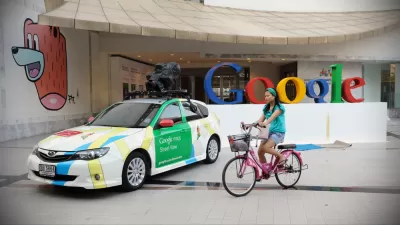The design reveal is more than just a showcase for architects Bjarke Ingels and Thomas Heatherwick. The project also raises tough questions about how far suburban cities in the South Bay Area are willing to go to support the current tech boom.
A New York Times article by Conor Dougherty first turned up the volume on talk about Google's new headquarters last week. According to Dougherty, "[the] project in Mountain View, which Google has not made public but has discussed with members of the City Council, is likely to aggravate an increasingly testy relationship between the company and community leaders who fear the company is overrunning their small city."
The problem created by the Google's continue expansion, according to city leaders, is too many jobs. The growth of tech companies is a controversial trend in many of the area's suburban municipalities: "The same story is playing out across Silicon Valley. In Menlo Park, home of Facebook, the November election featured a measure — ultimately rejected by voters — that would have cut downtown office growth in half. Citizen groups in nearby Palo Alto have rebranded their City Council’s most anti-development members as 'residentialists.'"
The article goes on to preview more holistic questions about housing and transportation infrastructure that the city's newly elected council will have to consider in the coming years.
Later in the week, Amy Frearson detailed the design proposal—which has the attention of the design and architecture media thanks to the projects to high-profile architects: Thomas Heatherwick and Bjarke Ingels. Here's how Frearson describes the project proposal: "The concept for Google North Bayshore is to create lightweight block-like structures that can be moved around, rather than investing in permanent buildings. According to Google, this will offer flexibility as the company invests in new product areas."
FULL STORY: Google Plans New Headquarters, and a City Fears Being Overrun

Planetizen Federal Action Tracker
A weekly monitor of how Trump’s orders and actions are impacting planners and planning in America.

Congressman Proposes Bill to Rename DC Metro “Trump Train”
The Make Autorail Great Again Act would withhold federal funding to the system until the Washington Metropolitan Area Transit Authority (WMATA), rebrands as the Washington Metropolitan Authority for Greater Access (WMAGA).

The Simple Legislative Tool Transforming Vacant Downtowns
In California, Michigan and Georgia, an easy win is bringing dollars — and delight — back to city centers.

The States Losing Rural Delivery Rooms at an Alarming Pace
In some states, as few as 9% of rural hospitals still deliver babies. As a result, rising pre-term births, no adequate pre-term care and "harrowing" close calls are a growing reality.

The Small South Asian Republic Going all in on EVs
Thanks to one simple policy change less than five years ago, 65% of new cars in this Himalayan country are now electric.

DC Backpedals on Bike Lane Protection, Swaps Barriers for Paint
Citing aesthetic concerns, the city is removing the concrete barriers and flexposts that once separated Arizona Avenue cyclists from motor vehicles.
Urban Design for Planners 1: Software Tools
This six-course series explores essential urban design concepts using open source software and equips planners with the tools they need to participate fully in the urban design process.
Planning for Universal Design
Learn the tools for implementing Universal Design in planning regulations.
Smith Gee Studio
City of Charlotte
City of Camden Redevelopment Agency
City of Astoria
Transportation Research & Education Center (TREC) at Portland State University
US High Speed Rail Association
City of Camden Redevelopment Agency
Municipality of Princeton (NJ)




























